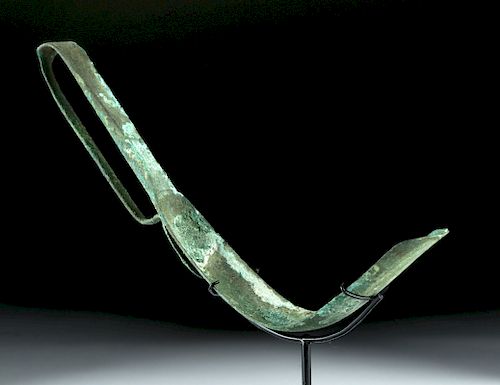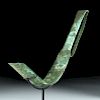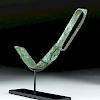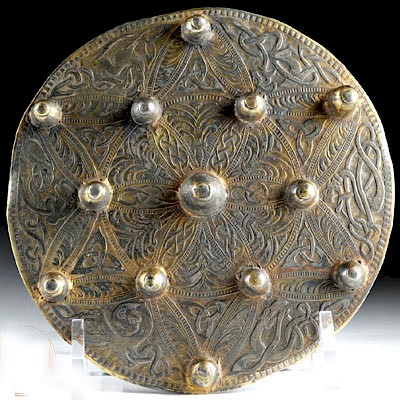Fine Greek Bronze Strigil
Lot 15a
About Seller
Artemis Fine Arts
686 S Taylor Ave, Ste 106
Louisville, CO 80027
United States
Selling antiquities, ancient and ethnographic art online since 1993, Artemis Gallery specializes in Classical Antiquities (Egyptian, Greek, Roman, Near Eastern), Asian, Pre-Columbian, African / Tribal / Oceanographic art. Our extensive inventory includes pottery, stone, metal, wood, glass and textil...Read more
Estimate:
$1,700 - $2,500
Absentee vs Live bid
Two ways to bid:
- Leave a max absentee bid and the platform will bid on your behalf up to your maximum bid during the live auction.
- Bid live during the auction and your bids will be submitted real-time to the auctioneer.
Bid Increments
| Price | Bid Increment |
|---|---|
| $0 | $25 |
| $300 | $50 |
| $1,000 | $100 |
| $2,000 | $250 |
| $5,000 | $500 |
| $10,000 | $1,000 |
| $20,000 | $2,500 |
| $50,000 | $5,000 |
| $100,000 | $10,000 |
| $200,000 | $20,000 |
About Auction
By Artemis Fine Arts
Jul 19, 2018
Set Reminder
2018-07-19 10:00:00
2018-07-19 10:00:00
America/New_York
Bidsquare
Bidsquare : Fine Antiquities/Ethnographic Art
https://www.bidsquare.com/auctions/artemis-gallery/fine-antiquities-ethnographic-art-3329
Featuring classical antiquities, ancient and ethnographic art from cultures encompassing the globe, plus fine art. Artemis Fine Arts info@artemisgallery.com
Featuring classical antiquities, ancient and ethnographic art from cultures encompassing the globe, plus fine art. Artemis Fine Arts info@artemisgallery.com
- Lot Description
Ancient Greece, Classical Period, ca. 5th to 4th century BCE. A beautiful and elegant hammered bronze strigil formed from a single narrow sheet with a wide, concave blade that curved and tapers to a rounded end. The blade straightens out to a slender handle with folded sides, narrowing dramatically along the verso, and ending at an ovoid terminal boasting a pair of pierced suspension holes. The entire tool is covered in thick areas of pale-green, dark-green, and russet-hued patina. Custom museum-quality display stand included. Size: 9.875" L x 1.5" W x 6.5" H (25.1 cm x 3.8 cm x 16.5 cm); 8.625" H (21.9 cm) on included custom stand.
The strigil was a scraper used in combination with olive oil and sand or pumice to exfoliate the skin after exercising or bathing. It was an essential piece of equipment for the typical Greek and Roman athlete, and as such came to symbolize athleticism itself. Greek cases abound with depictions of youthful athletes using strigils in the gymnasium. The celebrated sculpture by Lysippos, the Apoxyomenos of ca. 350 to 325 BCE, depicted a nude athlete scraping himself off with a strigil.
For a similar example, please see The Metropolitan Museum of Art, accession number 14.105.2: https://www.metmuseum.org/art/collection/search/248881
A similar example with an incised figure on the handle hammered for $9,000 at Sotheby's, New York Antiquities Auction (June 7, 2005, lot 2): http://www.sothebys.com/en/auctions/ecatalogue/2005/antiquities-n08104/lot.2.html
Provenance: private East Coast, USA collection
All items legal to buy/sell under U.S. Statute covering cultural patrimony Code 2600, CHAPTER 14, and are guaranteed to be as described or your money back.
A Certificate of Authenticity will accompany all winning bids.
We ship worldwide and handle all shipping in-house for your convenience.
#136221Surface wear and minor abrasions commensurate with age as expected, slight bending to overall form, very minor nicks to blade, handle, and terminal, and some roughness across most surfaces, otherwise intact and excellent. Nice earthen deposits and fabulous green and russet patina throughout.Condition
- Shipping Info
-
All shipping is handled in-house for your convenience. Your invoice from Artemis Gallery will include shipping calculation instructions. If in doubt, please inquire BEFORE bidding for estimated shipping costs for individual items.
-
- Buyer's Premium



 EUR
EUR CAD
CAD AUD
AUD GBP
GBP MXN
MXN HKD
HKD CNY
CNY MYR
MYR SEK
SEK SGD
SGD CHF
CHF THB
THB














